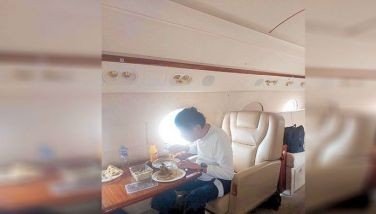DPWH has spent P2 trillion for Build, Build, Build — Villar

MANILA, Philippines — The Department of Public Works and Highways did well this year, DPWH Secretary Mark Villar proudly declared as he summed up his agency’s performance so far in 2019.
Villar said the DPWH has spent almost P2 trillion for President Duterte’s Build, Build, Build infrastructure program.
“To date, the Duterte administration is approaching P2 trillion in physical accomplishments. Almost P2 trillion because when we started in 2016, in 2017 and in 2018, we spent P590 billion. To date, we already spent P500 billion,” Villar said in an interview with The STAR.
A confident Villar said that by mid-2020, massive infrastructure projects will be seen by the public, including those that will drastically decongest the major but most problematic stretch of EDSA.
Villar added that the government could reduce to five minutes the travel time from Makati to Cubao on EDSA next year once the agency’s infrastructure projects and the improvement of mass transit are done.
At present, an estimated 350,000 to 400,000 vehicles ply EDSA daily.
With all the bridges, skyways and road widening projects that the DPWH has undertaken, EDSA will definitely be decongested and vehicles traveling on the busy thoroughfare significantly reduced to its logical capacity of 200,000 to 250,000 vehicles daily, according to the public works chief.
“Almost all the infrastructure projects that the DPWH has started since the Duterte government launched its Build, Build, Build program are almost complete,” Villar said, adding that by mid-2020, these infrastructure projects would be opened to motorists.
Not even Congress’ delayed approval of the national budget affected the performance of the DPWH, according to Villar, adding that the agency managed to catch up with its target accomplishment.
“Our department spent P590 billion last year. This year, as of Oct. 30, we spent about P500 billion. We are looking at spending up to around P700 billion by the end of the year. That is despite the delayed budget, we still made major accomplishments,” he said.
Villar noted that among the significant projects executed by the DPWH in 2019 are the Cavite-Laguna Expressway or CALAEX, bypass roads in major cities all over the country and the Southlink.
He said the DPWH has also started implementing the masterplan for Marawi City, which was devastated by the Maute terrorist group in 2017.
“We already started the Marawi masterplan. The masterplan is finished. We started construction of that. The roads outside are being constructed, like the Plaridel bypass,” Villar added.
President Duterte, according to Villar, is very “action-oriented,” that is why his Cabinet members are also hardworking.
“The President is very helpful. He is very action-oriented. He wants results. He really works. He wants accomplishments,” Villar said.
The CALAEX was inaugurated by Villar on Oct. 31, while the ramp that will connect Makati to Manila is almost complete.
DPWH earlier this month opened the Dagat-dagatan ramp of the 2.6-kilometer North Luzon Expressway (NLEX) Harbor Link.
Harbor Link is intended to facilitate direct access between Port Area in Manila and North and Central Luzon via the NLEX.
With the Harbor Link, motorists, especially those in the commercial trucking sector, will enjoy a hassle-free elevated expressway alternative to the choke points of EDSA-Balintawak, A. Bonifacio and C-3/5th Avenue. It is also envisioned for truckers who will be spared from the truck ban and subsequently experience quicker turnaround.
Villar said the foundation works of the first five-kilometer section of the NLEX connector expressway at the new Caloocan interchange, which will extend to the future Sampaloc interchange near España Boulevard in Manila, are now going full blast.
A total of 223 piers would be built to support the all-weather, all-vehicle NLEX connector which would interconnect with the Metro Manila Skyway stage 3 in Santa Mesa, Manila, according to the public works chief.
“Upon completion of the NLEX connector, travel time from NLEX to (South Luzon Expressway) will be reduced from the usual two hours to approximately 20 minutes,” he said.
Villar added that the elevated four-lane divided carriageway NLEX connector would feature two interchanges and four toll plazas running above the Philippine National Railway (PNR) lines.
The PNR right-of-way is being shared by the NLEX connector and the north-south commuter railway, which is also under construction.
“I think, at this point, the worst is over in terms of construction. The piling works are already done. That’s the heaviest. Talking about the southbound, the traffic (there) isn’t (as) bad as the northbound, and we built that ramp early. So I think that ramp can be used for the north and south. Once the one going north is done, we realign the ramp to service the southern portion so we can adjust it. So there is that option,” Villar said.
He added that traffic on SLEX would be easy next year once the north ramp is finished in July.
Everything in the expressway network is progressing as scheduled, according to Villar.
In the Visayas, the DPWH has started the Cebu Expressway, the Bacolod Economic Highway and the Boracay Circumferential Road.
The DPWH is also giving the Kalibo Bridge its finishing touches.
“There are other projects that I (haven’t) mention(ed) yet, but a lot of widening of roads, the widening of Maharlika – if you look at the Daang Maharlika, a lot of roads… are already widened. There are bypass roads all across the country. We have constructed a lot of bypass roads,” Villar said.
In Mindanao, the DPWH has a master plan for the road network in Zamboanga.
The agency has started the Marawi road masterplan as well as the Davao coastal road bypass.
The DPWH has completed the Cagayan de Oro bypass.
“Almost every major city has bypass roads that we have accomplished,” Villar said.
In Metro Manila, the Laguna Lake Highway is being completed.
“That was a big accomplishment in Metro Manila. Of course, the decongestion of EDSA. I think that would be one of the biggest accomplishments of this administration – to decongest EDSA… And it’s very challenging,” Villar said.
- Latest
- Trending



























